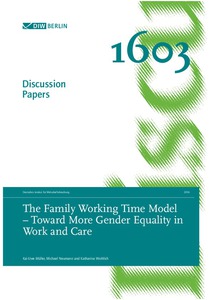The family working time model - toward more gender equality in work and care
"Since the millennium, the labor market participation of women and mothers is increasing across European countries. Several work/care policy measures underlie this evolution. At the same time, the labor market behavior of men and fathers, as well as their involvement in care work, is relatively...
| Main Authors: | , , |
|---|---|
| Institution: | ETUI-European Trade Union Institute |
| Format: | TEXT |
| Language: | English |
| Published: |
Berlin
2016
DIW |
| Subjects: | |
| Online Access: | https://www.labourline.org/KENTIKA-19101389124919295619-The-family-working-time-model-.htm |
| Summary: | "Since the millennium, the labor market participation of women and mothers is increasing across European countries. Several work/care policy measures underlie this evolution. At the same time, the labor market behavior of men and fathers, as well as their involvement in care work, is relatively unchanging, meaning that employed mothers are facing an increased burden with respect to gainful employment and providing care. We propose a family working time model that incentivizes fathers and mothers to both work in extended part-time employment. It provides a benefit in form of a lumpsum transfer or income replacement for each parent if, and only if, both parents work 30 hours per week. Thus, it explicitly addresses fathers and – contrary to most conventional family policies – actively promotes the dual earner/dual carer paradigm. Combining microsimulation and labor supply estimation, we empirically analyze the potential of the family working time model in the German context. The relatively small share of families already choosing the symmetric distribution of about 30 working hours would increase by 60 per cent. By showing that a lump-sum transfer especially benefits low-income families, we contribute to the debate about redistributive implications of family policies. The basic principles of the model generalize to other European countries where families increasingly desire an equal distribution of employment and care. In order to enhance the impact of such a policy, employers’ norms and workplace culture as well as the supply of high-quality childcare must catch-up with changing workforce preferences." |
|---|---|
| Physical Description: | 30 p. Digital |

